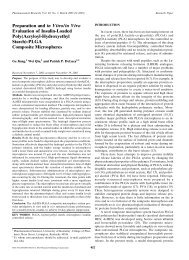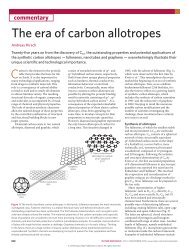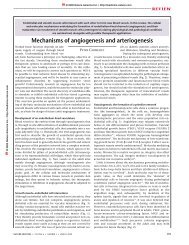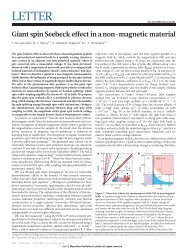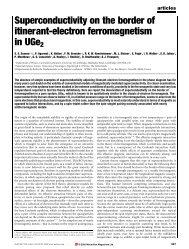Multi-hierarchical self-assembly of a collagen mimetic peptide from ...
Multi-hierarchical self-assembly of a collagen mimetic peptide from ...
Multi-hierarchical self-assembly of a collagen mimetic peptide from ...
You also want an ePaper? Increase the reach of your titles
YUMPU automatically turns print PDFs into web optimized ePapers that Google loves.
ARTICLES<br />
12. Krishna, O. D. & Kiick, K. L. Supramolecular <strong>assembly</strong> <strong>of</strong> electrostatically<br />
stabilized, hydroxyproline-lacking <strong>collagen</strong>-<strong>mimetic</strong> <strong>peptide</strong>s.<br />
Biomacromolecules 10, 2626–2631 (2009).<br />
13. Persikov, A. V., Ramshaw, J. A., Kirkpatrick, A. & Brodsky, B. Amino acid<br />
propensities for the <strong>collagen</strong> triple-helix. Biochemistry 39, 14960–14967 (2000).<br />
14. Persikov, A. V., Ramshaw, J. A. M., Kirkpatrick, A. & Brodsky, B. Electrostatic<br />
interactions involving lysine make major contributions to <strong>collagen</strong> triple-helix<br />
stability. Biochemistry 44, 1414–1422 (2005).<br />
15. Sakakibara, S. et al. Synthesis <strong>of</strong> (Pro-Hyp-Gly) n <strong>of</strong> defined molecular-weights –<br />
evidence for stabilization <strong>of</strong> <strong>collagen</strong> triple helix by hydroxyproline. Biochim.<br />
Biophys. Acta 303, 198–202 (1973).<br />
16. Shah, N. K., Ramshaw, J. A., Kirkpatrick, A., Shah, C. & Brodsky, B. A host–guest<br />
set <strong>of</strong> triple-helical <strong>peptide</strong>s: stability <strong>of</strong> Gly-X-Y triplets containing common<br />
nonpolar residues. Biochemistry 35, 10262–10268 (1996).<br />
17. Venugopal, M. G., Ramshaw, J. A., Braswell, E., Zhu, D. & Brodsky, B.<br />
Electrostatic interactions in <strong>collagen</strong>-like triple-helical <strong>peptide</strong>s. Biochemistry<br />
33, 7948–7956 (1994).<br />
18. Fallas, J. A., Gauba, V. & Hartgerink, J. D. Solution structure <strong>of</strong> an ABC <strong>collagen</strong><br />
heterotrimer reveals a single-register helix stabilized by electrostatic interactions.<br />
J. Biol. Chem. 284, 26851–26859 (2009).<br />
19. Gauba, V. & Hartgerink, J. D. Self-assembled heterotrimeric <strong>collagen</strong> triple<br />
helices directed through electrostatic interactions. J. Am. Chem. Soc. 129,<br />
2683–2690 (2007).<br />
20. Gauba, V. & Hartgerink, J. D. Surprisingly high stability <strong>of</strong> <strong>collagen</strong> ABC<br />
heterotrimer: evaluation <strong>of</strong> side chain charge pairs. J. Am. Chem. Soc. 129,<br />
15034–15041 (2007).<br />
21. Gauba, V. & Hartgerink, J. D. Synthetic <strong>collagen</strong> heterotrimers: structural mimics<br />
<strong>of</strong> wild type and mutant <strong>collagen</strong> type I. J. Am. Chem. Soc. 130, 7509–7515 (2008).<br />
22. Madhan, B., Xiao, J. X., Thiagarajan, G., Baum, J. & Brodsky, B. NMR<br />
monitoring <strong>of</strong> chain-specific stability in heterotrimeric <strong>collagen</strong> <strong>peptide</strong>s. J. Am.<br />
Chem. Soc. 130, 13520–13521 (2008).<br />
23. Ottl, J. et al. Design and synthesis <strong>of</strong> heterotrimeric <strong>collagen</strong> <strong>peptide</strong>s with a<br />
built-in cystine-knot. Models for <strong>collagen</strong> catabolism by matrixmetalloproteases.<br />
FEBS Lett. 398, 31–36 (1996).<br />
24. Russell, L. E., Fallas, J. A. & Hartgerink, J. D. Selective <strong>assembly</strong> <strong>of</strong> a high stability<br />
AAB <strong>collagen</strong> heterotrimer. J. Am. Chem. Soc. 132, 3242–3243 (2010).<br />
25. Cejas, M. A. et al. Thrombogenic <strong>collagen</strong>-<strong>mimetic</strong> <strong>peptide</strong>s: <strong>self</strong>-<strong>assembly</strong> <strong>of</strong><br />
triple helix-based fibrils driven by hydrophobic interactions. Proc. Natl Acad. Sci.<br />
USA 105, 8513–8518 (2008).<br />
26. Kar, K. et al. Self-association <strong>of</strong> <strong>collagen</strong> triple helix <strong>peptide</strong>s into higher order<br />
structures. J. Biol. Chem. 281, 33283–33290 (2006).<br />
27. Kar, K., Wang, Y. H. & Brodsky, B. Sequence dependence <strong>of</strong> kinetics and<br />
morphology <strong>of</strong> <strong>collagen</strong> model <strong>peptide</strong> <strong>self</strong>-<strong>assembly</strong> into higher order<br />
structures. Protein Sci. 17, 1086–1095 (2008).<br />
28. Kotch, F. W. & Raines, R. T. Self-<strong>assembly</strong> <strong>of</strong> synthetic <strong>collagen</strong> triple helices.<br />
Proc. Natl Acad. Sci. USA 103, 3028–3033 (2006).<br />
29. Paramonov, S. E., Gauba, V. & Hartgerink, J. D. Synthesis <strong>of</strong> <strong>collagen</strong>-like <strong>peptide</strong><br />
polymers by native chemical ligation. Macromolecules 38, 7555–7561 (2005).<br />
30. Yamazaki, C. M., Asada, S., Kitagawa, K. & Koide, T. Artificial <strong>collagen</strong> gels via<br />
<strong>self</strong>-<strong>assembly</strong> <strong>of</strong> de novo designed <strong>peptide</strong>s. Biopolymers 90, 816–823 (2008).<br />
31. Skrzeszewska, P. J. et al. Physical gels <strong>of</strong> telechelic triblock copolymers with<br />
precisely defined junction multiplicity. S<strong>of</strong>t Matter 5, 2057–2062 (2009).<br />
32. Rele, S. et al. D-periodic <strong>collagen</strong>-<strong>mimetic</strong> micr<strong>of</strong>ibers. J. Am. Chem. Soc. 129,<br />
14780–14787 (2007).<br />
33. Banwell, E. F. et al. Rational design and application <strong>of</strong> responsive alpha-helical<br />
<strong>peptide</strong> hydrogels. Nature Mater. 8, 596–600 (2009).<br />
34. Yang, Y. L., Leone, L. M. & Kaufman, L. J. Elastic moduli <strong>of</strong> <strong>collagen</strong> gels can<br />
be predicted <strong>from</strong> two-dimensional confocal microscopy. Biophys. J. 97,<br />
2051–2060 (2009).<br />
35. Mi, K. et al. Influence <strong>of</strong> a <strong>self</strong>-assembling <strong>peptide</strong>, RADA16, compared with<br />
<strong>collagen</strong> I and Matrigel on the malignant phenotype <strong>of</strong> human breast cancer cells<br />
in 3D cultures and in vivo. Macromol. Biosci. 9, 437–443 (2009).<br />
NATURE CHEMISTRY DOI: 10.1038/NCHEM.1123<br />
36. Greenfield, M. A., H<strong>of</strong>fman, J. R., de la Cruz, M. O. & Stupp, S. I. Tunable<br />
mechanics <strong>of</strong> <strong>peptide</strong> nan<strong>of</strong>iber gels. Langmuir 26, 3641–3647 (2010).<br />
37. Yokoi, H., Kinoshita, T. & Zhang, S. Dynamic re<strong>assembly</strong> <strong>of</strong> <strong>peptide</strong> RADA16<br />
nan<strong>of</strong>iber scaffold. Proc. Natl Acad. Sci. USA 102, 8414–8419 (2005).<br />
38. Zhang, S. G. et al. Self-complementary oligo<strong>peptide</strong> matrices support<br />
mammalian-cell attachment. Biomaterials 16, 1385–1393 (1995).<br />
39. Lamm, M. S., Rajagopal, K., Schneider, J. P. & Pochan, D. J. Laminated<br />
morphology <strong>of</strong> nontwisting beta-sheet fibrils constructed via <strong>peptide</strong><br />
<strong>self</strong>-<strong>assembly</strong>. J. Am. Chem. Soc. 127, 16692–16700 (2005).<br />
40. Ozbas, B., Kretsinger, J., Rajagopal, K., Schneider, J. P. & Pochan, D. J.<br />
Salt-triggered <strong>peptide</strong> folding and consequent <strong>self</strong>-<strong>assembly</strong> into hydrogels<br />
with tunable modulus. Macromolecules 37, 7331–7337 (2004).<br />
41. Aulisa, L., Dong, H. & Hartgerink, J. D. Self-<strong>assembly</strong> <strong>of</strong> multidomain <strong>peptide</strong>s:<br />
sequence variation allows control over cross-linking and viscoelasticity.<br />
Biomacromolecules 10, 2694–2698 (2009).<br />
42. Ottl, J. et al. Recognition and catabolism <strong>of</strong> synthetic heterotrimeric <strong>collagen</strong><br />
<strong>peptide</strong>s by matrix metalloproteinases. Chem. Biol. 7, 119–132 (2000).<br />
43. Serpell, L. C., Fraser, P. E. & Sunde, M. X-ray fiber diffraction <strong>of</strong> amyloid fibrils.<br />
Methods Enzymol. 309, 526–536 (1999).<br />
44. Okuyama, K. Revisiting the molecular structure <strong>of</strong> <strong>collagen</strong>. Connect. Tissue Res.<br />
49, 299–310 (2008).<br />
45. Pandya, M. J. et al. Sticky-end <strong>assembly</strong> <strong>of</strong> a designed <strong>peptide</strong> fiber provides<br />
insight into protein fibrillogenesis. Biochemistry 39, 8728–8734 (2000).<br />
46. Woolfson, D. N. Building fibrous biomaterials <strong>from</strong> alpha-helical and <strong>collagen</strong>like<br />
coiled-coil <strong>peptide</strong>s. Biopolymers 94, 118–127 (2010).<br />
47. Bella, J., Eaton, M., Brodsky, B. & Berman, H. M. Crystal and molecular<br />
structure <strong>of</strong> a <strong>collagen</strong>-like <strong>peptide</strong> at 1.9 Å resolution. Science 266,<br />
75–81 (1994).<br />
48. Okuyama, K., Okuyama, K., Arnott, S., Takayanagi, M. & Kakudo, M. Crystal<br />
and molecular structure <strong>of</strong> a <strong>collagen</strong>-like poly<strong>peptide</strong> (Pro-Pro-Gly) 10 . J. Mol.<br />
Biol. 152, 427–443 (1981).<br />
49. Pauling, L. & Corey, R. B. The structure <strong>of</strong> fibrous protein <strong>of</strong> the <strong>collagen</strong>-gelatin<br />
group. Proc. Natl Acad. Sci. USA 37, 272–281 (1951).<br />
50. Ramachandra, G. N. & Kartha, G. Structure <strong>of</strong> <strong>collagen</strong>. Nature 176,<br />
593–595 (1955).<br />
51. Ramachandran, G. N. & Kartha, G. Structure <strong>of</strong> <strong>collagen</strong>. Nature 174,<br />
269–270 (1954).<br />
52. Rich, A. & Crick, F. H. C. Molecular structure <strong>of</strong> <strong>collagen</strong>. J. Mol. Biol.<br />
3, 483–506 (1961).<br />
53. Ruozi, B., Tosi, G., Leo, E. & Vandelli, M. A. Application <strong>of</strong> atomic force<br />
microscopy to characterize liposomes as drug and gene carriers. Talanta<br />
73, 12–22 (2007).<br />
54. Wess, T. J., Hammersley, A., Wess, L. & Miller, A. Type-I <strong>collagen</strong> packing,<br />
conformation <strong>of</strong> the triclinic unit-cell. J. Mol. Biol. 248, 487–493 (1995).<br />
Acknowledgements<br />
This work was funded in part by National Science Foundation CAREER Award (DMR-<br />
0645474), the Robert A. Welch Foundation (Grant No. C1557) and the Norman<br />
Hackerman Advanced Research Program <strong>of</strong> Texas.<br />
Author contributions<br />
L.E.R.O. designed and performed the experiments (except SEM and fibre diffraction) and<br />
co-wrote the manuscript. J.A.F. performed and analysed fibre-diffraction experiments.<br />
E.L.B. performed the SEM experiments. M.K.K. performed the <strong>collagen</strong>ase experiments.<br />
J.D.H. supervised the research, evaluated all the data and co-wrote the manuscript.<br />
Additional information<br />
The authors declare no competing financial interests. Supplementary information<br />
accompanies this paper at www.nature.com/naturechemistry. Reprints and permission<br />
information is available online at http://www.nature.com/reprints. Correspondence and<br />
requests for materials should be addressed to J.D.H.<br />
828<br />
NATURE CHEMISTRY | VOL 3 | OCTOBER 2011 | www.nature.com/naturechemistry<br />
© 2011 Macmillan Publishers Limited. All rights reserved.



